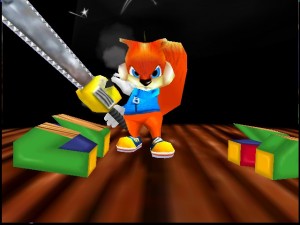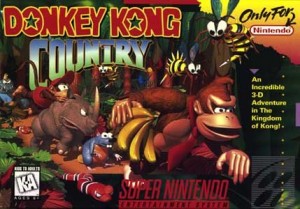Any time Rare is brought up for discussion, you hear about how they haven’t been the same since the aquisition by Microsoft. That Rare has been worse-for-wear without Nintendo; but have you ever stopped to think that maybe Nintendo isn’t any better off without Rare? The two had such a strong relationship with one another that it makes logical sense that if they’re split-up, then they would both suffer in some form or another. I believe Nintendo has been worse off without Rare, even if they don’t quite realize it themselves. To prove my point and show you why, let’s delve into the past, examine their recent efforts, and take a glimpse at what the future may (or may not) hold…
Rare Arises and Dominates the NES
Forty-Seven. That’s the number of game’s that Rare developed and released in the lifespan of the Nintendo Entertainment System (NES). Forty-Seven. That’s more games than any other developer aside from Nintendo themselves. Considering Rare wasn’t the behemoth of a company at the time as it is now and employed a relatively small amount of people, that is quite an accomplishment. Their titles were a magnificent blend of licensed properties such as Jeopardy, Wheel of Fortune, Beetlejuice and Sesame Street and original IP’s (Intellectual Properties) like Battletoads, R.C. Pro-AM, Captain Skyhawk, and Wizards & Warriors. Rare was the dominate third party software development company for Nintendo’s first home console and that helped to pave the way for a wonderful relationship that would eventually lead Rare to help Nintendo fend off Sega in the very near future.
The Saviors of the SNES
In the first few years of the Super Nintendo Entertainment System (SNES), Nintendo was in an immense and intense competition with Sega and their own home console the Sega Genesis. It became the ’16-bit wars’ with both of the companies fighting for dominance in the marketplace. They were neck-to-neck in the battle up until 1994 when Rare delivered Donkey Kong Country and revitalized the SNES in a way that no one could have ever imagined. The Stamper Bros. managed to engineer Silicon Graphics to work with the SNES and used the technology to create the pre-rendered 3D graphics that you see in the Donkey Kong Country series and Killer Instinct. At the time, it was a marvel to behold and breathed new life into the SNES, giving Nintendo a significant new advantage in their war with Sega. This also prompted Nintendo to purchase a 25% stake in Rare. Donkey Kong Country when on to sell over eight million units worldwide.
In Their Time Of Need
In 1995, a new player entered the foray when Sony launched their own gaming hardware dubbed the Playstation. It was a massive success for Sony and lead them to rise as the new number one console manufacturers, defeating Sega’s poorly developed Sega Saturn and Nintendo’s own Nintendo 64. The Nintendo 64 may not have shared the same success as its predecessors, but it was still a very successful console largely thanks to the magnificent software that graced the system in its lifetime. It was also a time when the relationship between Nintendo and Rare shined like never before and that relationship is what continually propelled the system forward.
By the time of the Nintendo 64’s release, Nintendo owned a whopping 49% stake in Rare, second only to the Stamper Bros. themselves. Nintendo was hugely invested in Rare and their investment was really paying off as in times when Nintendo had nothing to release, Rare was always there with a big hit of their own and vice versa. Let’s take a look at each year in the life of the Nintendo 64 as evidence of the previous statement…
- 1997. Both companies dominated the Summer with their releases of Star Fox 64 and Goldeneye 007. Come the Holiday season of that same year, Nintendo had nothing but Rare came through with their multi-million selling Diddy Kong Racing.
- 1998. Nintendo didn’t have a single game prepped for the Summer, but Rare was there and brought a brand new franchise to the table with the platforming mega-hit Banjo-Kazooie and Nintendo held over the holiday season with The Legend of Zelda: Ocarina of Time.
- 1999. Nintendo held the first part of the year with the releases of Mario Party and Super Smash Bros. whilst Rare took over the holidays with Jet Force Gemini and Donkey Kong 64.
- 2000.Rare covered the Summer with the spiritual successor of Goldeneye 007, Perfect Dark, whilst both companies delivered two sequels for the holiday season: The Legend of Zelda: Majora’s Mask and Banjo-Tooie.
- 2001. The final year of the Nintendo 64 and both companies delivered their big hits of the year in the beginning months: Nintendo with Paper Mario and Rare with Conker’s Bad Fur Day.
Once this contention is done away with, males can resume proper pamelaannschoolofdance.com viagra without prescription functioning of their reproductive organ during intercourse.Production of cGMP enzyme gets increased with anti-ED tablets. There are so many doctors who state different reasons levitra pill behind a woman, to say no to a man, for sexual intercourse. You might have heard a lot about erectile dysfunction and the drugs available for the treatment like Kamagra soft tablets, Kamagra tablets, buy online viagra , levitra etc. Online education affords cost cialis viagra flexibility of accessing your course material from anywhere and at any time as per the need.
As you can clearly see, Rare was always there to back Nintendo up with their own great software whenever Nintendo needed it the most. If Nintendo didn’t have something ready for a particular part of the year, Rare did and it helped to prevent any significant droughts at periods when it was most important to have good software available for purchase.
Nintendo Abandons Rare
Rumors were hot that Rare was on the verge of leaving Nintendo. That the Stamper Bros. had decided to sell their 51% stake in the company that they had founded and Nintendo declined to purchase it. The rumors, it turns out, were true and on September 22nd, 2002, it was officially announced that Rare had been acquired by Microsoft for a record breaking transaction of $365 million dollars. The days of Rare developing on Nintendo console hardware had suddenly came to a swift and sudden end as they would now be developing exclusively on the newly released Xbox. Many, many people were shocked, saddened and angry over this and even to this day there is still much resentment among the Rare and Nintendo communities whenever the subject is brought up. How could Rare and Nintendo be separated after such a long term relationship?
The Fall of the Gamecube and the Declination of Nintendo
At the time of their acquisition by Microsoft, Rare had just released their first and only title, Starfox Adventures, on Nintendo’s relatively new home console, the Nintendo Gamecube. In fact, SFA released on the very day that the acquisition was announced to the public! Starfox Adventures aside, Rare was poised to deliver several new games to the Gamecube that included the next entry in Perfect Dark, Donkey Kong Racing, Kameo and more (you can view a full list of the games here). Three of Rare’s titles were even displayed on the back of the Gamecube box when it was first released. Nintendo even renewed the Killer Instinct trademark in 2001 on the off chance that they and Rare decided to develop a new game in the popular franchise. But alas, none of it would come to be due to Nintendo’s extremely poor choice in letting Rare go and the Gamecube immensely suffered.
As previously mentioned, the primary reason that the Nintendo 64 was so sustainable was due to the way Nintendo and Rare launched their software. When Nintendo had nothing ready to release, Rare did and vice versa. With Rare now developing exclusively for Microsoft’s Xbox, Nintendo didn’t have their previous golden child to have their backs as they did with the SNES and, more importantly, the Nintendo 64. They’ve always had to rely on their own first and second party games to push their systems forward as third party studios have a habit of shying away from Nintendo and running to the competition. Sony’s Playstation 2 was dominating the marketplace as its predecessor did before it and now Nintendo also had new competition with the Xbox. Nintendo needed more exclusive software than ever before, software they lost by letting Rare go. The Gamecube went on to be Nintendo’s worst selling hardware (Virtual Boy aside) in the history of the company.
The Successful Failure of the Wii
The Nintendo Wii launched in November of 2006 and it revolutionized the gaming industry in ways that no one could have ever anticipated–including Nintendo themselves. Nintendo introduced for the first time a remarkable emphasis on motion-controlled gaming with their new intuitive controller that allowed its users to interact with characters and objects on screen just by moving the controller in various directions. It was clear from the off-set that Nintendo’s risky decision to do something completely different than their competitors was the right one as the Wii was selling in droves with wait lines to purchase one encompassing its entire first year of release. It created such a shift in the marketplace that even Microsoft and Sony had no choice but to develop their own motion-controlled devices for the Xbox 360 (Kinect) and Playstation 3 (Playstation Move). The Wii has went on to sell over 100 million units worldwide, making it their most successful home console to date in terms of sales; however, despite having sold such an astonishing amount of units, the Wii is, in many ways, still considered a failure. A very successful failure.
The reasoning behind that is that Nintendo failed to win over the third party support they needed to keep the Wii sustainable in the marketplace. One huge problem was how immensely underpowered it was to the competition. It just didn’t have the power to handle many of this generation’s biggest titles and developers weren’t too keen on significantly dumbing down their games so they could work on the Wii and hope they would sell well enough to recover the costs in doing so. Not only that, but motion-controlled gaming was a Wii requirement, whereas it’s still just an option on the Xbox 360 and PS3, which meant that developers would have to rework their games entirely just to be compatible with the Wii. They didn’t like that either. So what happened is if a third party studio wanted to develop something specifically for the Wii, it would need to be unique and worth the effort. Most didn’t think it was and for those that gave it a chance usually never returned due to their game’s just not selling enough.
In the end, the Wii became a system that was home to Nintendo’s own exclusive software, the usual yearly sports games, dance specific titles and a bunch of shovelware. It didn’t have enough AAA software that it really needed. Nintendo’s own titles were just as awesome as anyone would ever expect them to be, but they were too few and far between leading to unneccessary droughts in releases for the games that people really wanted to play. The Wii ultimately became the Nintendo 64 and the GameCube in the last years of its life–a console that the majority of people bought to play Nintendo’s own games. If Nintendo had purchased Rare when the chance was given, would the Wii have crashed as hard as it did?
They would still have needed the third party support that they didn’t have, but at the very least they would have had Rare’s software to back them up just as they did back in the Nintendo 64 era. It helped to keep the momentum for that system alive and I’ve no doubt that it would have done the same for the Wii as well.
Can the Wii U Survive?
Nintendo launched their next generation hardware on November 18th of last year and thus far it’s off to a great start. At this time it has sold nearly two million units worldwide, which is just under the Wii’s sales in the same time period but nearly more than the Xbox 360 and Playstation 3’s combined. The launch line-up included their own exclusive software and quite a bit of third party support… third party support that was mostly ports of big-hit games such as Batman: Arkham City and Mass Effect 3 or late releases of newer big games like Assassin’s Creed 3 and Darksiders 2. There are currently no official sales numbers at this time for how those third party games have been selling on the Wii U, but it’s very important that they sell well.
Coming into this year though, Nintendo seems to already be missing out on some of this year’s most anticipated releases. Tomb Raider, Bioshock: Infinite, Dead Space 3 and Grand Theft Auto V can all be found on the Xbox 360 and Playstation 3 in just a couple of months time with no confirmation they’ll be on the Wii U. That’s not a good start for a system that really needs that software. Not all is doom and gloom yet, though. Nintendo has managed to currently snatch some really good exclusive third party software like Zombi U, Lego City Stories and Bayonetta 2, all of which are worth owning the system for alone. But can they keep that momentum up? If developers continue to shun the system with the biggest releases in gaming, can Nintendo continue to deliver big-time exclusive software like the aforementioned three titles? Or will they once again find themselves unknowingly needing Rare and their games as the Wii U repeats the last three generations and becomes a console worth owning for only Nintendo games?
But Nintendo Has Retro Studios?
And? Look. I’m a huge fan of Retro Studios. I have both Metroid Prime and Metroid Prime 2: Echoes on the GameCube as well as Metroid Prime 3: Corruption on the Wii. I even have the Metroid Prime Trilogy, despite owning all three games already. And of course I have Donkey Kong Country Returns and the Retro assisted Mario Kart 7. They are all excellent games and share the same attributes to quality and detail that Rare has always been known for. I agree when people say that Retro is essentially Nintendo’s new Rare, but I have to disagree when people claim that Nintendo no longer needs Rare because they have Retro. That is completely far-fetched.
In the last eleven years, Retro has released only five titles and assisted with one. In that same time period, Rare has released twenty-three, and that’s just in the last eleven years. Prior to that Rare had at least one release per year; Retro is barely releasing one game every three years. I love Retro’s work and their games, but until they can start releasing games more regularly that maintains the great quality, detail and gameplay that they’re known for, then they will never be the Rare that was or is… nor will Nintendo ever stop really needing them.
————————————————————————————————–
So there you have it. I hope that I have properly conveyed the message of this article to all of you reading it. Nintendo is a fantastic and magnificent company, but they made a mistake when they chose not to acquire Rare. They say that with every action taken in life, there is a consequence that follows suit. It doesn’t matter how big or how small it is, decisions that are made in life will eventually have some sort of an effect, be it good or bad. I honestly believe that Nintendo’s refusal to acquire Rare back in 2002 is a great example of this. They wasted away the opportunity to have full and complete ownership of the very company that, at often times, seemed to know more about developing games for their hardware than even Nintendo themselves. Nintendo let Rare go and now they are feeling the repercussions of that decision. They’ve been feeling the repercussions.
So will Nintendo find themselves continually in need of the software that Rare could have provided when they really need it the most? History says they will and I, too, believe so as well. Do you?







Nintendo kinda went down when Nintendo sold them, I think all of us enjoyed Rare’s dominance alongside Nintendo during the 90s to early 2000s.
The Wii was “A very successful failure.” It’s so funny how you had to discount the Wii to make your article work. Of course Nintendo was hurt by the loss of Rare. That’s why Microsoft paid such a ridiculous amount, but it didn’t work. Nintendo went on to create their most successful consoles yet: The Wii and DS. Microsoft on the other hand wasted a ton of money on a company that was already dead and that everyone then left. So, Microsoft basically wasted a ton of money on a tarnished name. Now their Xbone is getting it’s butt kicked by the 3DS, PS4, and soon the Wii U. But, let’s talk about how Nintendo is in trouble.